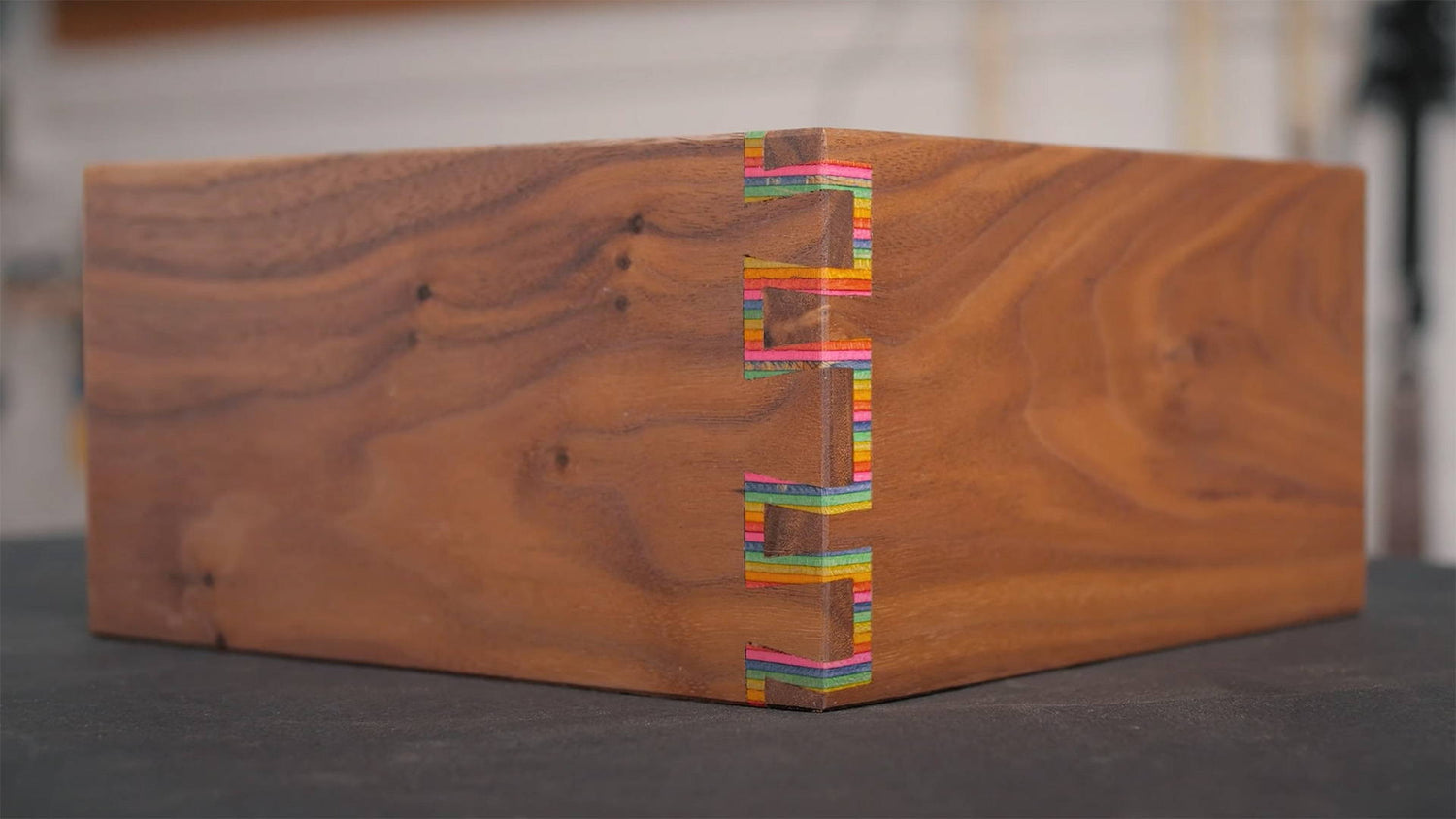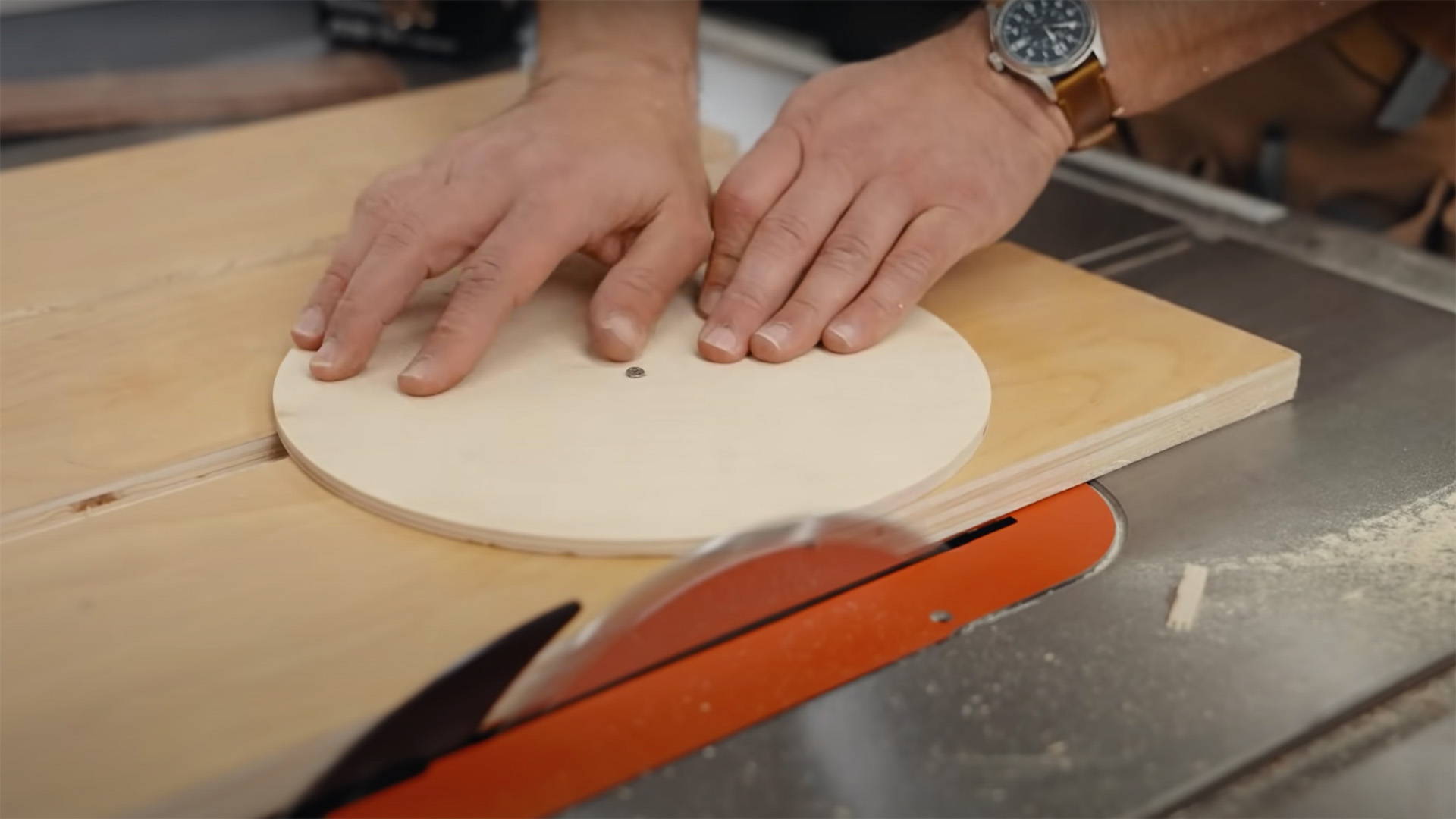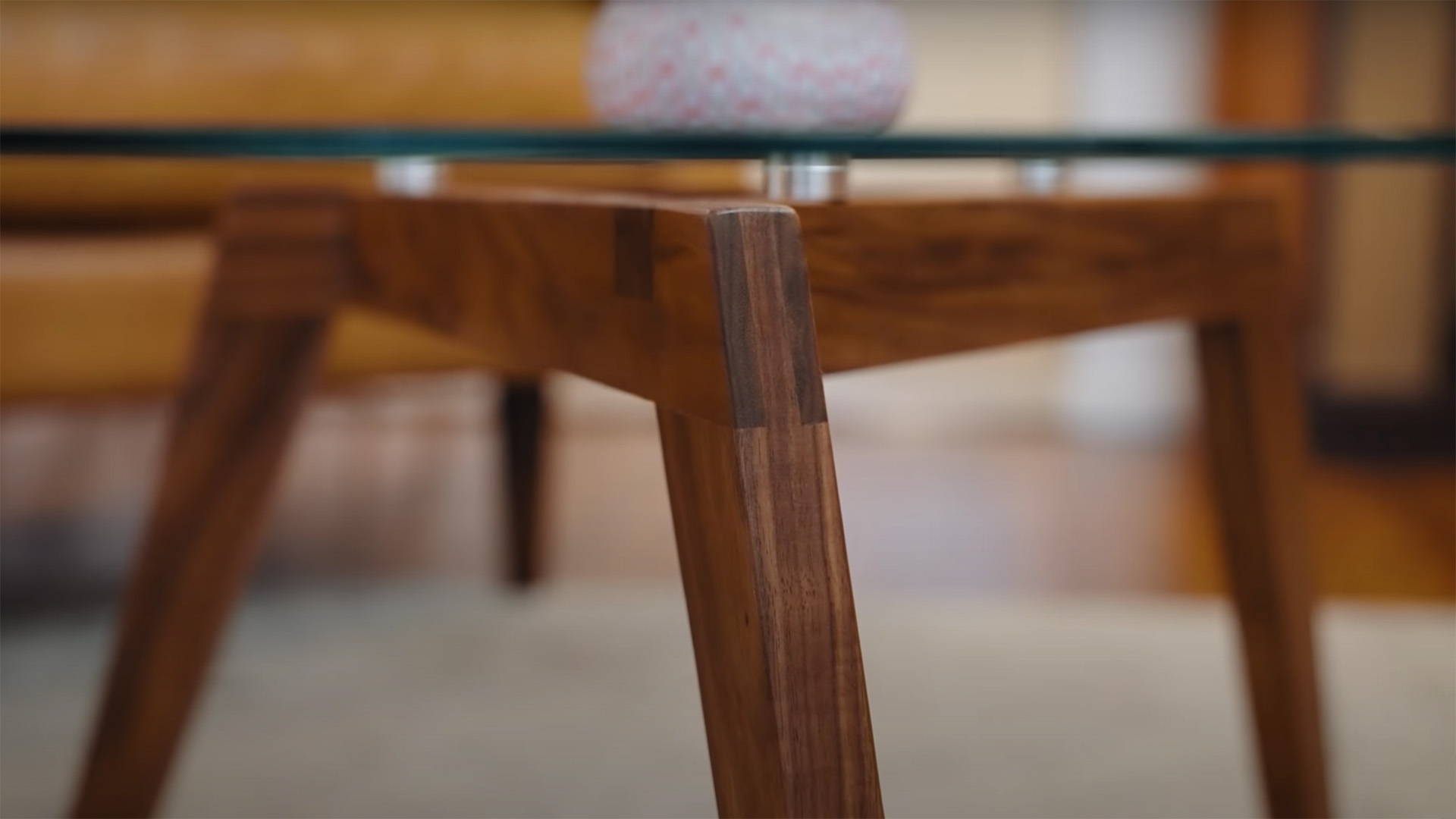Want to cut joinery that stops people in their tracks? Try your hand at inlaid dovetails.
Inlaid dovetails add an extra element of beauty to an already impressive joint.
And they’re easier than they look.
If you can cut regular dovetails, you’ll have no problem with inlays. (If you haven’t cut dovetails before, read this first).
In truth, inlaid dovetails are purely decorative. They’re not going to make your build any stronger — but definitely won’t make it weaker if done correctly.
I’m going to explain the process for creating an inlay that zig zags around your pins and tails like the one pictured above.
So if you have a flair for the purely aesthetic (and every woodworker should a little), read on and learn how to tackle this beautiful joint.
TABLE OF CONTENTS
- What are Inlaid Dovetails?
- Are Inlaid Dovetails Difficult to Make?
- Inlaid Dovetails: The Basic Steps
- It All Starts with a Rabbet
- Cut the First Set of Tails
- Cut the First Set of Pins and Assemble
- Flush Trim the Inlay Board
- Layout the Final Set of Tails
- Complete the Dovetails
- Inlaid Dovetail Variations
WHAT ARE INLAID DOVETAILS?
Inlaid dovetails are dovetails with a piece of wood inlaid between or around the pins and tails.
They look best when the inlay is done with a contrasting wood species, like maple inlay in walnut dovetails (or rainbow veneer inlay in anything).
Different processes will create different styles of inlay, from a single wrapped line, to 3D effects, to multiple seemingly disconnected inlays.
Through-dovetails, half blinds, mitered dovetails — you can make inlaid versions of them all.
But in this post, I’m looking specifically at how to cut inlaid through dovetails.
ARE INLAID DOVETAILS DIFFICULT TO MAKE?
The difficulty of inlaid dovetails depends on your experience.
If you’ve got a handle on regular dovetails, inlays won’t be hard.
But if you’ve never cut a set of dovetails before, I recommend starting there. Here’s the full step-by-step dovetail process, and some tips for cutting your first set.
Using a dovetail guide also really helps. You need to saw at the same tails angle multiple times (whether 8:1 or 6:1) for an even inlay — and a dovetail guide makes consistency easy.
In essence, cutting inlaid dovetails is just cutting dovetails twice. But the result looks way more difficult than the process lets on.
They’re twice the work — but twice the glory.
INLAID DOVETAILS: THE BASIC STEPS
I’m going to explain the process for one set of inlaid dovetails. If you’re making a box, you’ll have four joints total.
You need a pin and tails board of the same species. In our example, we’re using walnut.
I like to cut these from consecutive pieces of a single board to get a grain wrap effect.
You’ll then need another board for your inlay. A contrasting species looks best, and maple’s the classic pairing with walnut. But use anything you like.
Here are the basic steps:
1. Mill your tails board, pins board, and inlay board to the same width. The thickness doesn’t have to be the same (I’ll sometimes make the inlay board a bit thicker so it shows on the inside of the joint).
2. Cut a rabbet on the tails board. The depth of the rabbet will equal the thickness of your inlay line.
3. Cut the tails on the tails board, then transfer them to the inlay board and cut the pins.
4. Glue the tails board and inlay board together and let dry.
5. Flush cut the inlay board to the tails board.
6. Cut a new set of tails on the tails board, offsetting your lines from the original tails by the thickness of the original rabbet (I’ll explain this more below).
7. Transfer the new tails to the pins board and cut the pins.
8. Assemble the final joint and admire your work!
If that list of steps is enough for you — then get to it.
But if you need a bit more explanation, let’s get into the nitty gritty.
IT ALL STARTS WITH A RABBET
The critical step for inlaid dovetails is cutting a rabbet on the tails board.
I actually do this on every set of dovetails, since it makes the process easier. But for inlays it isn’t optional.
The depth of the rabbet determines the thickness of the inlay line.
I usually like a thin inlay — around ⅛” thick. We’ll stick with that in our example.
Set your marking gauge so the blade is ⅛” from the fence.
MARKING GAUGE TIP
Any good square has the measurements etched into the blade. This makes it easy to accurately set your marking gauge.
Place the end of the ruler against the marking gauge fence, then adjust the blade until it clicks into the etched mark at ⅛”.
Lock it down and you’re good to go.
Use the marking gauge to scribe a line on the end grain of the tails board. Make sure to reference the fence off the backside (not the show face).
Now set your marking gauge to the thickness of the inlay board. It’s easy to do by setting the fence on the inlay board, letting the blade drop to the surface below, and locking it down.
With this setting, mark a line all the way around the tails board.
Now you can cut the rabbet.
I do this with a crosscut sled on the table saw. Take your time to make sure your cuts are at the correct depth and right on your lines.
Afterward, clean the rabbet up with a shoulder plane or router plane so it’s perfectly flat.
CUT THE FIRST SET OF TAILS
Now you’ll lay out your tails.
Keep in mind: Your final set of tails will be wider than these — meaning your final pins will be smaller.
Account for this by laying out the first set of tails so the pins are wider than the final size you’re after.
If you want to be exact, lay it out so the pins are ¼” wider than the final width (this accounts for the ⅛” inlay on each side).
Now just cut the tails as you normally would.
CUT THE FIRST SET OF PINS AND ASSEMBLE
Using a dovetail alignment board or your preferred method, transfer the tails to the end grain of the inlay board.
For the base line of the pins, set your marking gauge on the rabbet of the tails board. You don't want to reference the full width of the board — just the rabbeted section.
Cut the pins on the inlay board, then glue and assemble the joint.
Fill in any gaps with a thin layer of glue and sawdust. I find it’s best to use the sawdust from the darker of the two wood species you’re using.
Let the joint dry for at least an hour (overnight is ideal) before you move on to the next step.
FLUSH TRIM THE INLAY BOARD
Once the joint’s dry, it’s time to flush trim the inlay board.
There’s a few ways to do this.
You could use a hand saw to take off the bulk of material then clean up with a hand plane. You could also make the cut on the table saw (just make sure to be as precise as possible).
Worse comes to worst, you can always run the entire board through a planer to ensure the inlay is flat to the rest of the tails board.
You may need to rejoint the sides to make sure they’re flat. If you do, make sure to remill the pins board to the same dimensions.
NOTE: FULL BOX BUILD
If you’re making a box with inlaid dovetails at all corners, start by building and assembling the entire thing with regular dovetails.
Once the glue’s dry, cut the box in half with a band saw or table saw. Then flush trim the remaining inlay boards as needed.
LAYOUT THE FINAL SET OF TAILS
This is the last step in the process that differs from regular dovetails.
Mark the tops of the new tails on the end grain, offset from the original tails.
Make sure you offset these lines away from the original tails so you end up sawing into the inlay pins.
To create an inlay of even thickness, offset your lines by the depth of the original rabbet. In our example, that’s ⅛”.
For example, measure ⅛” from one side of a tail and mark a line there. Then do the same from the other side.
Make sure to label your waste so you don’t get confused.
Once the layout is done, cut the tails.
Be careful to stay parallel to the original tails. Again, I recommend using a dovetail guide to ensure you stay accurate.
COMPLETE THE DOVETAILS
Once your final set of tails are cut and cleaned up, complete the joint as you would regular dovetails.
Trace the tails onto the pins board, cut the pins, then glue and assemble the joint.
Add a bit more sawdust to hide any gaps, and you’re done.
All that’s left is to sand, add finish, and gloat.
INLAID DOVETAIL VARIATIONS
Here are other ways to cut inlaid dovetails for different designs.
3D INLAID DOVETAILS
This type of inlay creates a sort of 3D effect, where the inlay ends up covering the end grain of the tails.
The process is similar to the one above. But instead of first assembling the tail and inlay board as pins and tails, you connect them as two sets of tails (connected flat, not at 90°).
INLAID HALF BLIND DOVETAILS
I’ve done inlaid half blinds two different ways.
In one, the inlay wraps around each individual tail for a disconnected pattern of geometric lines. It looks super rad.
The other version looks a lot more like the zig zag design I go into detail on above, but only shows on one side of the joint.
DOVETAILED MITERED CORNERS
Want to get weird? Try your hand at these suckers.
DOUBLE, TRIPLE, INFINITY INLAID DOVETAILS
Use the same method outlined in detail above can be repeated to create double, triple, even octuple inlaid dovetails.
Your only limit is time — and common decency.
INLAY AWAY
Inlaid dovetails are an amazing way to show off your woodworking skills and add eye-grabbing detail to your builds.
If nothing else, they’re great for practicing your dovetail technique. And they lend themselves beautifully to creativity and crazy ideas.
So if you’ve got the time — and a fancy for purely aesthetic pursuits — get in the shop and start sawing those tails.
Too much? Just enough? What are your thoughts on inlaid dovetails? Let us know in the comments below!
Follow us on Instagram @katzmosestools, on TikTok @katzmoseswoodworking, and check out my YouTube channel for more great woodworking content...
And as always, STAY SAFE IN THE SHOP!











3 comments
Anonymous
still trying to master dovetailts but once i do i will try this thanks for your help
still trying to master dovetailts but once i do i will try this thanks for your help
Andy
What’s the rainbow board you’ve used here? Had a quick google and couldn’t find anything similar
What’s the rainbow board you’ve used here? Had a quick google and couldn’t find anything similar
Jim
Love your tutorials. They are a challenge for me, but always fun to try. Great looking boxes. I will give it a go.. Have to get better at the dovetails.
I am a retired, 73, and spent my career behind a desk, but like working with my hands and staying active.
Thanks, Jim
Love your tutorials. They are a challenge for me, but always fun to try. Great looking boxes. I will give it a go.. Have to get better at the dovetails.
I am a retired, 73, and spent my career behind a desk, but like working with my hands and staying active.
Thanks, Jim